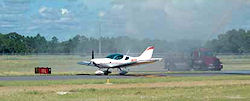Safety-driven Runway Project Paves Way to Environmental Accolades

The desire to enhance safety, increase capacity and reduce noise led to the addition of a new parallel runway at St. Lucie County International Airport in Florida last September. But the idea had been brewing for more than a decade.
|
Facts & Figures Project: Runway 10L-28R Airport: St. Lucie County (FL) International Airport Airport Owner: St. Lucie County Board of County Commissioners Approximate Cost: $15 million Funding: FAA, FL Dept. of Transportation & Local Grants Engineering Consultant & Construction Manager: PBS&J General Contractor: Dickerson Florida Geotechnical Engineer: Ardaman & Associates Recognitions: National Association of Counties Award, Florida Airports Council Environmental Excellence Award & Southeast AAAE General Aviation Project of the Year Award |
Between traffic from on-airport schools and pilots-in-training at nearby Embry-Riddle Aeronautical University and Florida Institute of Technology, flight education constitutes 65% of the airport's operations, notes Cox. The current array of training schools at St. Lucie International includes Aviator College of Aeronautics, TradeWinds Flight School and US Sport Aircraft.
Traffic from the Bahamas and beyond is lured to the airport's international catchment area, Cox adds. "We have a lot of varied businesses on the airport - close to 30 businesses employing 600 people," he relates, noting fixed base operators and ambulance charters to small manufacturing.
Prior to the addition of 10L-28R last fall, St. Lucie had two runways: 10R-28L, a primary instrument runway approximately 6,500 feet in length, and a 14-32 crosswind runway. Now, the airport has east-west parallel runways.
"The addition of 10L-28R allows our flight training activities to stay on the airport," Cox relates. "It segregates those operations from itinerant and local business and corporate traffic. It also assists in reducing noise impacts to the surrounding community by siphoning the training operations over to the new runway."
Environmental Interests
In addition to the reduction of the noise footprint, many other environmental aspects were taken in to consideration for St. Lucie's new runway project.
|
A new parallel runway helps segregate flight training activity from itinerant traffic at St Lucie County Int'l. |
In preparation for the project, the airport established a new Florida scrub jay conservation habitat and other mitigation areas for wetlands that have been lauded with accolades for environmental stewardship and sustainability. To date, the project has received the National Association of Counties Award, the Florida Airports Council Environmental Excellence Award and the Southeast AAAE General Aviation Project of the Year Award. The scrub jay habitat may also become a national training ground for U.S. Fish and Wildlife Services, Cox adds.
 "This has been a great project for the airport," he relates. "The awards we have received are a result of the interaction of our consultants and our local and federal regulatory agencies."
"This has been a great project for the airport," he relates. "The awards we have received are a result of the interaction of our consultants and our local and federal regulatory agencies."
PBS&J was among the consultants that contributed to the final product. In addition to collaborating on wildlife conservation efforts, the firm worked with local utilities to realign canals and relocate transmission lines, chronicles project manager/engineer of record Craig Sucich.
Realignment & Relocation
"The location of the runway was going to cross two existing master canals required of Fort Pierce Farms Water Control District," Sucich explains, noting that the entity works in conjunction with the South Florida Water Management District and owns/operates a number of canals throughout St. Lucie County.
|
St. Lucie County Commissioner Paula Lewis lands on the new runway at St. Lucie County International Airport. |
"We worked with them and came up with some different ideas as how to improve drainage in those areas and ensure that their customers further upstream wouldn't be impacted by what we were doing," he relates. "They agreed to it, and they now have two canals that swing out around the runways."
High voltage transmission lines running almost the entire length of the west side of the airport were also a concern. If left in place, the lines would have crossed directly over the new runway and taxiway.
The airport's master plan had previously identified the need to address the lines, Sucich recalls. "This project actually triggered having to do something about it," he notes. After working with Florida Power & Light to determine how far the lines needed to be moved, 1,500 feet of transmission lines were relocated around the end of the runway to the west to move them away from the airspace or approach to the new runway.
In terms of engineering, Sucich says the project was "pretty straightforward." Permitting requirements and coordinating between agencies, however, made it "complicated and interesting."
"The county and the airport did a great job of helping to try to fast-track certain things and make sure all of the agencies were talking to one another," he comments. "It was a great team effort."
FREE Whitepaper
PAVIX: Proven Winner for All Airport Concrete Infrastructure
International Chem-Crete Corporation (ICC) manufactures and sells PAVIX, a unique line of crystalline waterproofing products that penetrate into the surface of cured concrete to fill and seal pores and capillary voids, creating a long lasting protective zone within the concrete substrate.
Once concrete is treated, water is prevented from penetrating through this protective zone and causing associated damage, such as freeze-thaw cracking, reinforcing steel corrosion, chloride ion penetration, and ASR related cracking.
This white paper discusses how the PAVIX CCC100 technology works and its applications.










